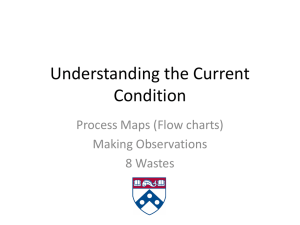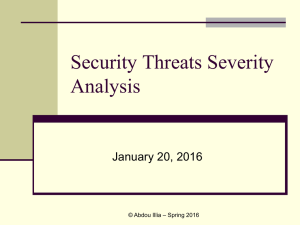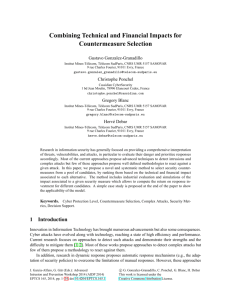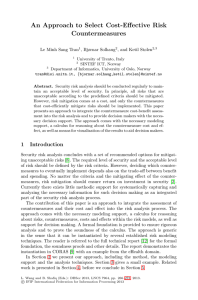Risk Management Principles & Guidelines (NCBJ)
advertisement
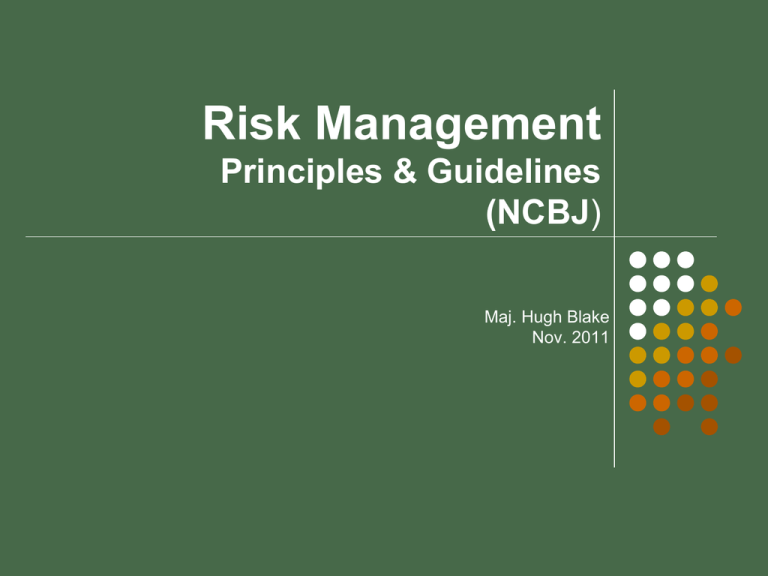
Risk Management Principles & Guidelines (NCBJ) Maj. Hugh Blake Nov. 2011 Why talk about risk? Risk is something that we all face every day. As a company, we have to take risks in pursuit of our commercial objectives. To raise awareness that we all have to manage risk as part of our daily working lives as well as personal. What do we know about RM? RM is part of our every day lives: Crossing the road Managing our finances Purchase of insurance Choosing to smoke Going for a swim - Risk of getting run-over – Risk of going broke – Risk of fire, theft, storm – Risk of cancer – Risk of drowning The choices we make in choosing to accept these risks is part of who we are Perception of risk – Simple Example Which method of transportation has the greatest fatality rate? By Boat By Air By Road – Car By Road – Motorbike Walking Cycling Train Research results By Boat By Air By Road – Car By Road – Motorbike Walking Cycling Train 5th 7th 4th 1st 2nd 3rd 6th Perception of risk cont’d.. Our perceptions usually determine our view of the level of risk posed by an activity Attitude to Risk Risk Aware SETTLER Knows that there are risks out there Doesn’t want to chance anything PIONEER Understands the Risks Takes chances but stays in control Risk Averse Risk GOPHER Doesn’t know what’s out there & doesn’t care Stays underground where its safe COWBOY Does what he feels like Doesn’t think (or care) about the risk Risk Oblivious Taking Sources of Business Risk Physical Environment Environmental Sources of Risks Physical Exposures Economic Environment Social Environment Political Environment Financial Asset Exposures e ic teg m m Stra a gr Ope ro rati ona P l t Projec Human Asset Exposures Org. Objectives Legal Environment Operational Environment Cognitive Environment Legal Liability Exposures Moral Liability Exposures The Effect of Risk control on Performance High Managing Risk to Managing Risk Enhance to enhance performance Performance Performance Excessive controls minimise risk and constrain performance Exposed & destroying performance Low Ignorant Managing Level of Risk Control Obsessed What is Risk Management? Definition of Risk Management ISO / IRM: Coordinated activities to direct and control an organisation with regards to risk. It generally includes risk: assessment, treatment, acceptance & Communication. Contained in ISO 31,000:2009(E) RM definition contd… A process whereby organisations methodologically address the risks attaching to their activities with the goal of achieving sustained benefit within each activity and across the portfolio of all activities. Sustained Benefit Benefits of Implementing the International RM Standards Increase likelihood of achieving objectives Encourage proactive management Improve awareness of need to identify and treat risk throughout the organisation Improve the identification of opportunities and threats Comply with legal and regulatory requirement and international norms Improve mandatory and volutntary reporting Benefits contd… Improve governance Improve stakeholder confidence and trust Establish a reliable basis for decision making and planning Improve control Effectively allocate and use resources for risk treatment Improve operational effectiveness and efficiency Enhance health and safety performance, as well as environmental protection Benefits contd… Improve loss prevention and incident management Minimize losses Improve organisational learning Improve organizational resilience International Standard Principles Creates value Integral par of organisational processes Part of decision making Explicitly addresses uncertainty Systematic, structured and timely Based on the best available information Tailored Takes human and cultural factors into account Principles contd… Transparent and inclusive Dynamic, iterative and responsive to change Facilitates continual improvement and enhancement of the organisation RM Framework 2. Establish the risk assessment process Establish the context The strategic context The organisational context § The RM context § Develop criteria § Decide structure § § Identify risks What can happen? How can it happen? § § Analyse Risk Determine existing controls Communicate and consult Determine likelihood Determine consequence § § Evaluate risks Compare against criteria Set risk priorities Accept Risk No § § § § § Monitor and review Estimate level of risk Treat Risks Identify treatment options Evaluate treatment options Select treatment options Prepare treatment plans Implement plans Yes Risk Identification Identify an organisation’s exposure to uncertainty Widely used approach is to break the risks down into categories: Strategic/commercial risks Economic/financial/market risks Legal, contractual and regulatory risks Organisational management/human factor Political/societal factors Environmental factors/Acts of God Technical/ operational/infrastructural risks Methods of Identifying Events Facilitated workshop Interviews Targeted questionnaire Process flow analysis Leading Event Indicator and Escalation Trigger Loss event data tracking Risk Analysis Risk analysis is concerned with the probability and impact of individual risks, taking into account any interdependence. Probability is the evaluated likelihood of a an event actually happening, including consideration of frequency of occurrence Impact is the evaluated effect or result of a particular risk actually happening Example of Risk Probability Framework Probability Criteria Very low 0-5% (extremely unlikely, or virtually impossible) Low 6-20% (low but not impossible) Medium 21-50% (Fairly likely to occur) High 51-80%(more likely to occur than not) Very high >80%(almost certain to occur) Example of Impact Framework Cost Impact Very low $0 to $100,000 Low >$100,000 to <$500,000 Medium >$500,000 to <$1,000,000 High >$1,000,000 to < $5,000,000 Very high >$5,000,000 Impact Contd… Budgetary Impact Very low 0 to 3%: Negligible effect on projected cost Low 3 to 10%: Small increase Medium 10 to 30%: Significant increase High 30 to 75%: Large increase Very high >75% Major increase XXX Ltd. Risk Management Value Chain Identify Key Business Objectives (1) Identify Key Processes; Dependencies and Enablers (2) Identify key Threats and Indicators (3) Identify likelihood and Severity/impact of Occurrence of Threat (4) Assess Countermeasures (5) Develop Action Plan (6) Business Objectives Identified: The management of XXX Ltd. production Inventory outlined their primary objective as the ability to efficiently meet the production demand for raw materials. However, to achieve this goal, the following sub-objectives / enablers would have to be met: 1. 2. 3. 4. 5. Proper Material Requirement Planning (MRP) and forecasting. Efficient execution of the Purchasing Plan. Proper receipt, storage and maintenance of stores. Proper issue procedure. Proper accounting for perpetual inventory. Risk Ranking Table The following is used to assign impact, probability and urgency weights to identified risks / issues. What will be the IMPACT on the ability to achieve the object? 1 5 15 30 50 Negligible Small Noticeable Significant Major LIKELIHOOD (A): - If it is not occurring, how likely is it to occur? 1 2 4 6 10 Unlikely to Occur Likely to occur rarely Likely to occur Highly likely to occur Certain to occur LIKELIHOOD (B): - If event is already occurring, how often does it occur? 1 2 4 6 10 Rarely Occasionally Frequently Daily Continuously URGENCY (A): - How soon is action required to prevent impact? 1 2 4 6 10 1 year 6 months 1 quarter 1 month 1 week URGENCY (B): - How soon is action required to mitigate impact? 1 2 4 6 10 Year 6 months 1 quarter 1 month Immediately Production Inventory: Proper accounting for perpetual inventory (FIFO & Expiration) Enablers Threats Countermeasure In Place Is threat occurring Yes Efficient inventory computer based management system Accurate input information System failure due to crash, virus or physical destruction of hardware Information contained on system is backed-up on a routine basis and storage is done offsite Staff mistakes and Management’s negligence resulting supervision and in inaccurate physical vigilance stock checks X Frequent physical stock count Poor planning and management Efficient internal control system at all stages of management Poor supervision and management Lack of documentation of accepted procedures Verification procedure for incoming stores Stock count scheduled and verified by Internal Audit Department Performance evaluation system as well as the productivity incentive system All procedures documented under ISO Prob Existing countermeasure is adequate L X L X L X L X L X L Recommended Countermeasure Freq L X Improper operation of Recruitment of the system due to qualified individuals incompetence of staff and training of staff Inaccurate supplier information No Probability & frequency rating Conduct stock counts with a minimum of two independent counters. With the assistance of the IAD, establish documented counting procedure and train staff accordingly. Existing countermeasure is adequate Existing countermeasure is adequate Existing countermeasure is adequate Sanction must be brought against management’s and supervisor’s negligence Existing countermeasure is adequate Production Inventory: Assessment and ranking of threats facing the enablers of objective #4 Srl 01 Risk ALE Impact Likeli Urgency Score hood Rank System failure due to crash, virus or physical destruction of hardware Staff mistakes and negligence resulting in inaccurate physical stock checks Improper operation of the system due to incompetence of staff Inaccurate supplier information 5 2 1 10 6th 5 6 6 180 2nd 5 6 6 180 2nd 5 4 2 40 5th 03 Poor planning and management 30 2 1 60 4th 04 Poor supervision and management 15 4 4 240 1st Lack of documentation of accepted procedures 5 4 4 80 3rd 02 Remark Risk Treatment Can involve: Avoiding the risk – not to start or continue an activity taking or increasing risk in order to pursue an opportunity removing the risk source Changing the likelihood Changing the consequences Transferring the risk or sharing with another party Retaining the risk by informed decision Monitor performance and modify as needed Summary All entities exist to provide value for it’s stakeholders Uncertainty presents risks and opportunities – with potential to erode / enhance value All entities face uncertainty – management’s challenge “balance the risk and opportunities” RM provides management with a framework to effectively deal with uncertainty – the associated risks and opportunities – and enhance their capability to build value. “Organisations make and save money by taking risks and lose money by not effectively managing risk” Thank you!!






